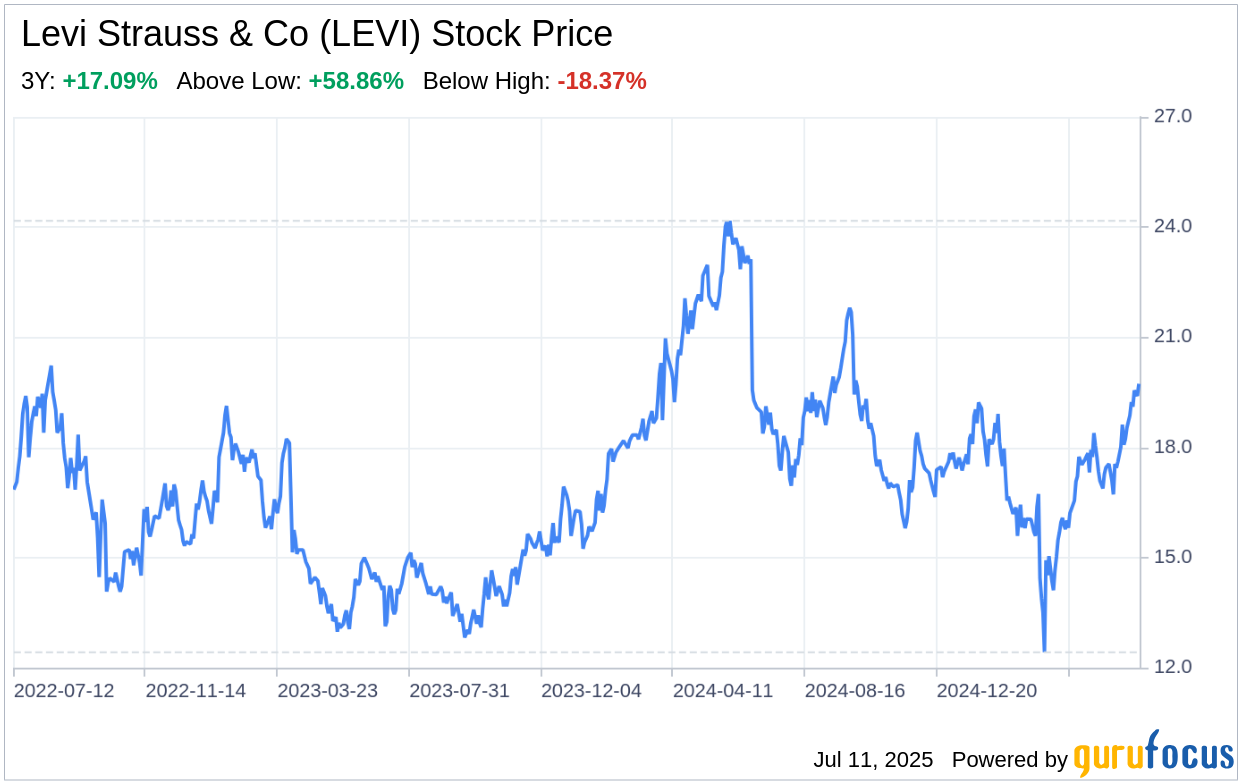On July 10, 2025, Levi Strauss & Co (LEVI, Financial) filed its 10-Q report, revealing a financial snapshot of the company's performance. As a globally recognized apparel company, LEVI designs, markets, and sells a wide range of clothing items and accessories under its flagship brands. The company operates through three regional segments, with the Americas being the primary revenue driver. The latest financial tables indicate a year-over-year increase in net revenues from $1,358.8 million to $1,446.0 million for the three months ended June 1, 2025, and from $2,839.0 million to $2,972.8 million for the six months ended. Gross profit also saw a significant rise, suggesting improved operational efficiency. However, the company reported a net income decrease from discontinued operations, reflecting strategic shifts in its brand portfolio. This SWOT analysis delves into the strengths, weaknesses, opportunities, and threats as discerned from LEVI's recent financial performance and strategic initiatives.

Strengths
Brand Power and Heritage: Levi Strauss & Co's brand strength is a testament to its enduring legacy and market presence. With a history dating back to 1853, LEVI has cultivated a reputation for quality and authenticity that resonates with consumers globally. The company's iconic Levi's® brand is synonymous with denim, giving it a competitive edge in the apparel industry. This brand equity is reflected in the company's ability to command premium pricing and maintain customer loyalty, contributing to its robust gross profit margin of 62.6% for the three months ended June 1, 2025.
Direct-to-Consumer (DTC) Growth: LEVI's strategic focus on expanding its DTC channel has proven fruitful, with the channel now generating 51% of net revenues in the first six months of 2025. This shift towards DTC allows LEVI to have greater control over brand presentation, customer experience, and data collection, leading to more targeted marketing and product development. The company's investment in e-commerce, which represents 23% of DTC channel net revenues, underscores its commitment to digital transformation and meeting consumer shopping preferences.
Weaknesses
Dependence on Wholesale Channel: Despite the growth in DTC, LEVI still relies heavily on its wholesale channel, which generated 49% of net revenues in the first six months of 2025. This dependence exposes the company to risks associated with wholesale customers' financial health and market dynamics, such as department store closures and shifts in consumer shopping behavior. The volatility in this channel can impact inventory management and necessitate increased promotional activities, potentially eroding margins.
Operational Challenges: The company's recent filing indicates potential strain on its U.S. distribution centers, which could affect its supply chain efficiency. As LEVI continues to navigate global productivity and outsourcing actions, there is a risk of business disruption or inadequate mitigation of such disruptions. This could lead to increased operational costs and impact the company's ability to deliver products in a timely manner, affecting customer satisfaction and sales.
Opportunities
International Expansion: LEVI's international business, including Europe and Asia segments, contributed 46% of net revenues in the first six months of 2025. There is significant potential for growth in emerging markets where brand penetration is lower. By leveraging its strong brand image and adapting to local consumer preferences, LEVI can expand its global footprint and diversify its revenue streams.
Sustainability and Innovation: Consumers are increasingly valuing sustainability and ethical practices in their purchasing decisions. LEVI's commitment to sustainability, as evidenced by its initiatives in water conservation and sustainable materials, positions the company as a leader in corporate responsibility. This focus on innovation and sustainability not only enhances brand reputation but also opens up opportunities for new product lines and collaborations that resonate with environmentally conscious consumers.
Threats
Global Economic Uncertainties: The apparel industry is sensitive to economic fluctuations, and global uncertainties such as trade tensions, geopolitical conflicts, and the aftermath of the COVID-19 pandemic can impact consumer spending and supply chains. LEVI's international presence exposes it to currency exchange risks and potential trade barriers, which could affect its cost structure and profitability.
Competitive Landscape: The fashion industry is highly competitive, with numerous players vying for market share. Fast fashion brands, in particular, pose a threat to LEVI's market position due to their ability to quickly respond to changing fashion trends and offer products at lower price points. LEVI must continuously innovate and adapt to maintain its relevance and appeal to a diverse consumer base.
In conclusion, Levi Strauss & Co (LEVI, Financial) demonstrates strong brand equity and a growing DTC presence, which are key strengths in the competitive apparel industry. The company's focus on sustainability and innovation presents opportunities for expansion and deeper consumer engagement. However, reliance on the wholesale channel and operational challenges are areas that require strategic attention. Global economic uncertainties and a competitive landscape are external threats that LEVI must navigate. Overall, the company's strategic initiatives and financial health position it to leverage its strengths and opportunities while addressing its weaknesses and threats.
This article, generated by GuruFocus, is designed to provide general insights and is not tailored financial advice. Our commentary is rooted in historical data and analyst projections, utilizing an impartial methodology, and is not intended to serve as specific investment guidance. It does not formulate a recommendation to purchase or divest any stock and does not consider individual investment objectives or financial circumstances. Our objective is to deliver long-term, fundamental data-driven analysis. Be aware that our analysis might not incorporate the most recent, price-sensitive company announcements or qualitative information. GuruFocus holds no position in the stocks mentioned herein.
